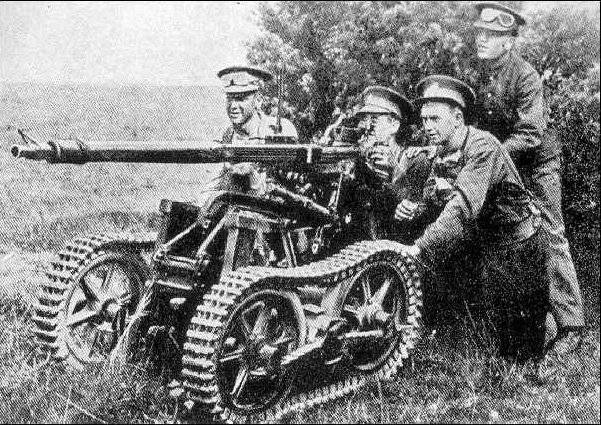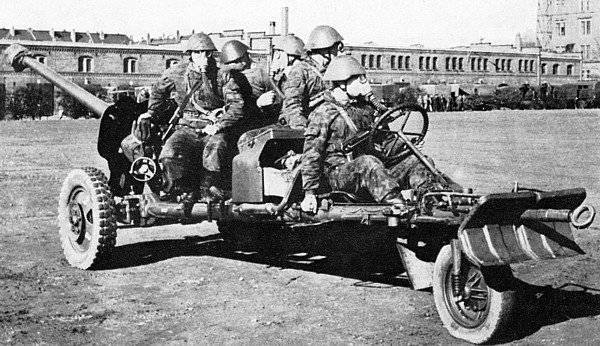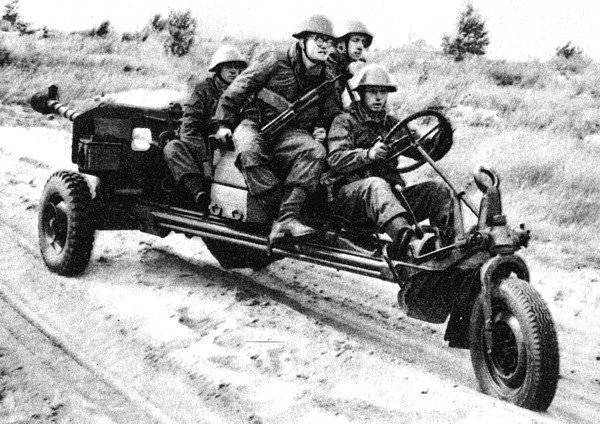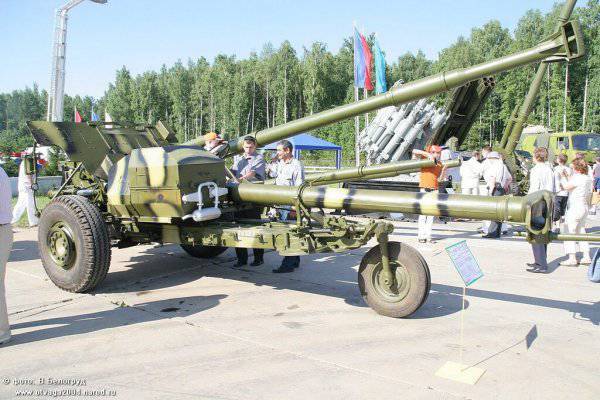Domestic self-propelled artillery
"Arsenalets"
The first step in a new direction was made in 1923, at the Leningrad plant "Krasny Arsenalets". Designers N. Karateev and B. Andrykhevich developed a compact lightly armored self-propelled chassis for the 45-mm battalion gun. Inside the armored hull of the construction, called the Arsenalets, was an opposed gasoline engine rated at 12 horsepower, which accelerated the chassis weighing a little less than a ton to 5-8 kilometers per hour. Obviously, with such driving characteristics, the Arsenalets could not keep up with the troops on the march, so the tracked course was supposed to be used only for moving directly on the battlefield. Another characteristic feature of the design was the absence of any seat for calculating the gun. The fighter-driver followed the Arsenalts and drove them with two levers. The prototype self-propelled gun was assembled only in the 1928 year and did not achieve significant success. Of course, the military was interested in the self-propelled chassis for field artillery, but the Arsenalets' design did not provide any protection to the calculation. After testing the project was closed.

Self-propelled gun "Arsenalets" is often referred to the class of self-propelled artillery installations. Due to the absence of any serious ACS projects at the time of its development, such a classification can be considered correct. At the same time, the later self-propelled guns of domestic and foreign production were armored chassis with mounted guns and means of protecting fighters. Naturally, all the soldiers-artillery no longer had to go for their weapons on foot. So no less correctly, the Arsenalets can be attributed to another class of artillery, which appeared and was formed two decades later - self-propelled guns (LMS).
CD-44
In 1946, the anti-tank gun D-44 caliber 85 millimeters was adopted by the Soviet army. This tool, developed in Sverdlovsk OKB-9, actually united the entire experience of creating guns of this class. The design of the gun was so successful that the D-44 is still in service in our country. Soon after the gun was adopted by the Ural engineers under the leadership of F.F. Petrova began to work out a project to increase its mobility through its own engine. The project was prepared only for the beginning of 49 year, when it was approved by the Ministry of Armaments. The next few years were spent on testing, identifying and correcting deficiencies. In November, the 1954 of the self-propelled gun was put into service under the designation SD-44.

When developing a self-propelled gun carriage, OKB-9 designers took the path of least resistance. The barrel group of the original D-44 gun did not change at all. Barrel-piece with a two-chamber muzzle brake and breech remained the same. Substantial refinement undergone gun carriage guns. A special metal box was attached to its left frame, inside of which was placed the M-72 motorcycle engine with 14 horsepower. Engine power was transmitted to the drive wheels through the clutch, gearbox, main shaft, rear axle, cardan drive and final drives. The engine and gearbox controls were placed in the trunk part of the left frame. In the same place the seat for the driver and the steering unit was mounted. The latter was a node consisting of a steering column, a turning mechanism and a guide wheel. During the transfer of the cannon into a fighting position, the steering wheel was folded sideways up and did not prevent the collar of the bed from resting on the ground.
In the stowed position, the SD-44 gun weighed about two and a half tons. At the same time, it could drive at speeds up to 25 km / h, and 58 liters of gasoline were enough to cover 22 kilometers. However, the main method of moving the gun was still towing with other vehicles with more serious driving characteristics. It is noteworthy that a winch for self-pulling was part of the equipment of the CD-44. In the stowed position, its cable was stored on the bulletproof shield, and if necessary it was fixed on a special drum on the axis of the driving wheels. Thus, the winch drive was carried out using the main engine M-72. To transfer a gun from a combat position to a marching position and vice versa, the calculation of five people required no more than a minute. With the advent of the military transport aircraft An-8 and An-12, it became possible to transport the SD-44 cannon by air and also to parachute it with a parachute.
CD-57
Shortly after the end of World War II, a whole series of artillery guns were developed in our country. Among others, an anti-tank gun X-26 caliber 57 millimeters was created. This gun had a barrel in length 74 caliber with a wedge gate, hydraulic recoil devices, as well as a carriage with two beds and a wheel drive. The serial production of the H-26 cannon began in the 1951 year. At the same time, the idea arose to increase the mobility of the weapon due to the possibility of moving around the battlefield without using a tractor, especially since OKB-9 was already closely involved in this issue. OKBL-46, which developed the gun, transferred all the necessary documentation to Plant No. 9 in Sverdlovsk: both enterprises had to design a self-propelled gun on the basis of the H-26. The technical task provided for installation on a ready engine of the engine, transmission and related equipment. In addition, it was necessary to maintain the possibility of towing various tractors for transportation over long distances. Sverdlovsk engineers prepared the project SD-57, OKBL-46 - Ч -71. In general terms, both versions of the gun's motorization were similar. However, in the 1957, the SD-57 gun, which had the best characteristics, was put into service.

The gun itself during the modernization has not undergone any major changes. The monoblock barrel was still equipped with a highly efficient muzzle brake of a two-chamber system. The wedge bolt had a copy type system and automatically opened after each shot. The barrel group of the SD-57 cannon is connected with the hydraulic recoil brake and spring-operated knuckle. Guidance mechanisms, bulletproof shield, etc. details also remained the same. The carriage, which had to be equipped with an engine, underwent a noticeable improvement. On the left side of the carrier sheet mounted a special frame for the engine M-42. The carburetor engine had two cylinders and gave horsepower up to 18. The engine was connected to the clutch, gearbox (three gears forward and one back), several shafts and final drives. The rotation was transmitted to the wheels of the gun carriage, located directly under the gun. 35 liters of gasoline were in the tanks inside and outside the bed. To enable self-driving and control the direction of movement on the right frame (as viewed from the breech of the cannon), a special unit was assembled, combining the steering wheel, steering mechanism and steering column. In addition, in the same part of the frame housed the gear lever and pedals. When casting the cannon into a fighting position, the wheel was folded sideways. The origin of the wheels of the self-propelled gun carriage is remarkable: the driving wheels were taken from the GAZ-69 car, and the steering wheel - from the Moskvich-402. For the convenience of the gunner-driver, a seat was installed on the same right frame. In the middle part of the body there were fastenings under the box with ammunition. The SD-57 gun in the stowed position weighed about 1900 kg. Together with the calculation of five people on the highway, it could accelerate to 55-60 kilometers per hour.
However, its own engine was designed exclusively for small crossings right on the battlefield. To the place of the battle the gun was supposed to be towed by any suitable vehicle. In addition, the dimensions and weight of the gun allowed, if necessary, to transport it with suitable aircraft or helicopters. So, CD-57 could be transported, including on the recently appeared Mi-4 helicopter. One of the first to receive a new cannon airborne troops. The implication was that it was self-propelled guns that should provide the landing forces with adequate fire support. Indeed, CD-57 had the opportunity not only to landing landing, but also parachuting. At the same time, the power of the gun caused certain complaints. At the end of 50, the caliber in 57 millimeters was clearly insufficient to destroy some armored targets. Thus, SD-57 could successfully fight only with enemy light armored vehicles and field fortifications.
CD-66
The main way to increase the fire power of artillery is to increase the caliber. Simultaneously with SD-57, OKB-9 was developing another self-propelled gun, this time in millimeters 85 caliber. The basis for the CD-66 project was the anti-tank gun D-48, developed at the very end of the forties. By design, it was generally similar to the D-44, but differed in a number of technological and design nuances. In particular, the D-48 received a new muzzle brake, absorbing up to 68% recoil. The tests of the D-48 began as early as 1949, however, they were seriously delayed due to the refinement of some components and assemblies. For example, just a few weeks after the start of the test, the designers were asked to develop a new muzzle brake that would not send as many hot gases to the gun crew. As a result, the adoption of the D-48 cannon took place only in 53.
In November, 1954, the OKB-9 was tasked to modify the D-48 cannon to the state of a self-propelled gun. Already in the early stages of the CD-48 project, it became clear that some new decision would be needed regarding the undercarriage of the gun. The original D-48, along with the carriage, weighed about 2,3 tons - motorcycle engines would not have coped with the task. For this reason, a corresponding request was sent to NAMI in Moscow. In September of the next 1955, the staff of the Automotive and Automotive Institute completed the design of the NAMI-030-6 engine, hp 68. and transmissions for it. During this time, Sverdlovsk designers managed to develop a four-wheeled chassis with a ball strap and reclining openers. The four-wheel platform was equipped with bridges from the GAZ-63 car and a similar control system. Due to the significant renewal of the appearance of the self-propelled gun carriage, CD-48 could conduct circular shelling of targets. The new carriage was quite complicated and heavy. Therefore, to transfer the gun from the traveling position to the combat position and back, it was necessary to introduce a separate hydraulic system with mechanisms for raising and lowering the gun.
In 1957, the SD-66 project was reviewed at the Main Artillery Directorate, where it became the object of criticism. For quick transfer of the weapon into a combat position, it was necessary to transport the gun with the barrel forward, which was impossible with the used chassis. Also, claims have arisen on the rigidity of the structure and its wear during operation. Nevertheless, GAU recommended trying to correct the identified deficiencies and assemble the layout of a self-propelled gun. Shortly thereafter, the project was closed due to the impossibility of correcting all the shortcomings. It is worth noting that the first unsuccessful experience with a self-propelled four-wheeled chassis for a gun affected the further development of this direction: after SD-66, all domestic SDs were made according to a three-wheel scheme worked out on SD-44 and SD-57.
"Sprut-B"
The latest at the moment domestic self-propelled weapon is the gun 2А45М "Sprut-B", developed in OKB-9. The barrel of a 125 caliber millimeter has no rifling and is equipped with a muzzle brake of the original design. Launch tool "Sprut-B" was originally designed to be towed, but having the ability to move independently. In front of the anti-bullet shield of the cannon, to the right of the barrel (when viewed from the breech) there is an armored box inside which the engine is located. The basis of the power plant "Spruta-B" is a MeMZ-967А engine with hydraulic drive. Engine power is transmitted to the drive wheels located directly below the breech of the gun. On the left side of the trunk is located the driver's workplace with the steering wheel and other controls. An interesting design of the gun carriage. Unlike previous self-propelled guns, the Sprut-B has a three-bed support structure, which allows it to conduct circular shelling of targets. When translating the cannon into a combat position, the front frame remains in place, and the side frames are raised to the side and fixed. The forward directing wheel fastens on a forward bed and leans back upwards. The drive wheels, in turn, rise above ground level, and the gun rests on the frame and the central support plate.
Due to the large combat weight of the gun - 6,5 tons - transfer to the combat or marching position is carried out using the hydraulic system, which reduces the transfer time to a half to two minutes. Great weight affected the speed of movement: the gun’s own engine provides no more than ten kilometers per hour on a dry dirt road. Low speed with independent movement is more than offset by the towing capabilities. With the help of Ural-4320 trucks or MT-LB trucks, the Sprut-B gun can be towed along the highway at speeds up to 80 km / h. Thus, the driving parameters of the gun when towing are limited only by the capabilities of the selected tractor.
The Sprut-B cannon is interesting not only for equipment for independent movement on the battlefield. The caliber and smooth barrel allow you to use the same range of ammunition that is used with domestic guns tanks. Separate-shell shots allow you to successfully deal with the whole range of targets for the destruction of which anti-tank artillery is intended. So, to destroy enemy tanks there is a VBM-17 sub-caliber projectile, and a VOF-36 shot is intended for firing at weakly protected targets and manpower of the enemy. In addition, guided missiles 2M45 with laser beam guidance can be launched from the barrel of the 9A119M gun. Such ammunition increases the radius of reliable destruction of targets by direct aiming up to four kilometers and provides penetration of 700-750 mm of homogeneous armor for dynamic protection.
***
Self-propelled guns are one of the most original ideas ever used in artillery. At the same time, they did not receive significant distribution and there are several reasons for this. Firstly, at the time when the first full-fledged SDO projects appeared, the leading countries of the world could either strive to provide each gun with its own tractor. Equipment for independent movement looked only an additional measure. The second reason was the relative complexity of the production of such weapons. Despite the apparent simplicity - to install the engine and transmission on the carriage - the designers faced several rather complex tasks. The main factor that made it difficult to do everything quickly and simply was the shock and vibration that occurred during the shooting. Not every engine can cope with such a load without damaging its own design. Finally, the widespread use of self-propelled guns was hindered by views on the tactics of a hypothetical war. In fact, only the airborne troops, which needed a compact and light artillery suitable for landing or parachute landing, really needed BMS. The reason for this was the relatively low payload capacity available. aviation technicians. After the appearance of heavy military transport aircraft and helicopters, the airborne forces were able to fully use the "combined arms" guns and tractors for them. Accordingly, the acute need for self-propelled artillery disappeared.
And yet you shouldn't make a bonfire for the LMS for seeming uselessness. The possibility of independent movement on the battlefield and beyond in a certain situation can save the lives of artillery soldiers or ensure timely repulsing of the attack. It is worth remembering that the class of self-propelled guns appeared as a result of the Second World War, when the mobility of field artillery had a high priority and was able to drastically affect the outcome of the battle or the whole operation. Currently, the leading armies of the world are moving to new structures, implying the creation of highly mobile units. Perhaps in the new look of the world armies there will be a place for self-propelled guns.
On the materials of the sites:
http://vadimvswar.narod.ru/
http://zw-observer.narod.ru/
http://russianarms.mybb.ru/
http://warfare.ru/
http://rusarmy.com/
http://dogswar.ru/
http://русская-сила.рф/
http://bastion-karpenko.narod.ru/

Information